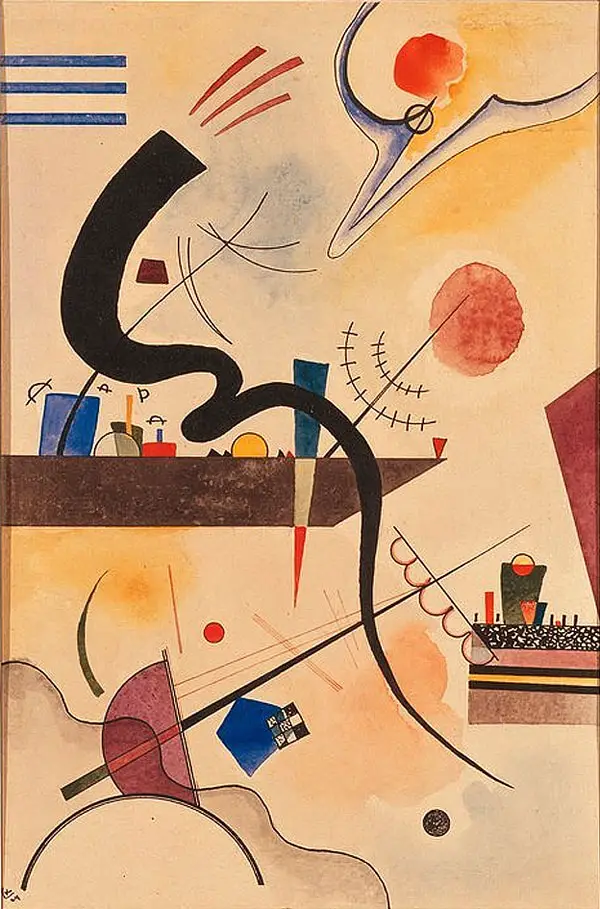There are some good parts - when he compares arbstract art to music. Lots of music is abstract. No one says, "I just don't get it," when they hear a work of music without words or allusion to meaning in the title. They just enjoy it or they don't. Why doesn't abstract art receive the same unbiased response?
I highlighted three things in the book that were meaningful to me. If these get you going, you might want to read more. A lot of the book addresses the idea about tension between elements as being a key factor in an artwork. Tension is a term my mentor/teacher uses and which I have struggled to understand. So it was helpful to read WK's take on the subject. I wouldn't say I had a light-bulb moment, but I did start to understand more deeply why this is important.
Here are Kandinsky's quotes:
ONE: "In fact no materializing of external forms expresses the content of a work of painting, but rather the forces = tensions which are alive within it.
If by some magic command these tensions were to disappear or to expire, the work, which is alive at that very instant, would die. On the other hand, every accidental grouping of several forms could be called a work of art. The content of a work of art finds its expression in the composition: that is, in the sum of the tensions inwardly organized for the work."
TWO: "This is the straight line whose tension represents the most concise form of the potentiality for endless movement. For the concept "Movement" which is used almost everywhere, I have substituted the term 'Tension.' The customary term is inexact and thereby leads us down the wrong roads and is the cause of further terminological misconceptions. 'Tension" is the force living within the element and represents only one part of the creative 'movement.' The second part is the 'direction.' which is also determined by the 'movement.' The elements of painting are material results of movement in the form 1. of the tension, and 2. of the direction."
THREE: in the chapter on Plane,: "It must only be mentioned here that abstract art must reckon with a more precise form that representative art, and that the pure question of form is in the first case essential and in the second, very often immaterial."
Beyond those three quotes, I have to say the book was too dense for me. It is interesting to contemplate how WK thought he was at the very dawn of a new age of art (he was) and that the future would hold much more investigation of the elements he laid out. (either it didn't or I don't know about it). I'm sure someone somewhere has followed in his footsteps, but that direction never became the mainstream of abstract art.
 |
Calm Bend, Watercolor on paper.
1924
13.6" x 8.9" Walker Art Center |
I highlighted three things in the book that were meaningful to me. If these get you going, you might want to read more. A lot of the book addresses the idea about tension between elements as being a key factor in an artwork. Tension is a term my mentor/teacher uses and which I have struggled to understand. So it was helpful to read WK's take on the subject. I wouldn't say I had a light-bulb moment, but I did start to understand more deeply why this is important.
 |
| Wassily Kandinsky: Black Accompaniment, 1924 |
Here are Kandinsky's quotes:
ONE: "In fact no materializing of external forms expresses the content of a work of painting, but rather the forces = tensions which are alive within it.
If by some magic command these tensions were to disappear or to expire, the work, which is alive at that very instant, would die. On the other hand, every accidental grouping of several forms could be called a work of art. The content of a work of art finds its expression in the composition: that is, in the sum of the tensions inwardly organized for the work."
TWO: "This is the straight line whose tension represents the most concise form of the potentiality for endless movement. For the concept "Movement" which is used almost everywhere, I have substituted the term 'Tension.' The customary term is inexact and thereby leads us down the wrong roads and is the cause of further terminological misconceptions. 'Tension" is the force living within the element and represents only one part of the creative 'movement.' The second part is the 'direction.' which is also determined by the 'movement.' The elements of painting are material results of movement in the form 1. of the tension, and 2. of the direction."
 |
|
THREE: in the chapter on Plane,: "It must only be mentioned here that abstract art must reckon with a more precise form that representative art, and that the pure question of form is in the first case essential and in the second, very often immaterial."
Beyond those three quotes, I have to say the book was too dense for me. It is interesting to contemplate how WK thought he was at the very dawn of a new age of art (he was) and that the future would hold much more investigation of the elements he laid out. (either it didn't or I don't know about it). I'm sure someone somewhere has followed in his footsteps, but that direction never became the mainstream of abstract art.